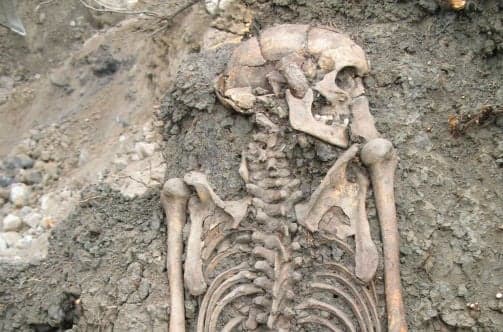Half of Viking city of Sigtuna were immigrants: study

No fewer than half the population of the Viking town of Sigtuna were immigrants, a new genetic analysis of human remains from the 10th to the 12th century has discovered.
While rough half of the 38 people whose bones and teeth were genetically tested grew up in or around the nearby Lake Mälaren area, the other half came from as far away as Ukraine, Lithuania, northern Germany, the British Isles, and parts of central Europe, as well as from southern Sweden, Norway and Denmark.
“It was a sort of Viking Age Scandinavian Shanghai or London,” Anders Götherström, Professor of Molecular Archeology at Stockholm University, told the TT newswire. “Anyone who wanted to do something, to work their way up in the church or in politics were first forced to come to Sigtuna.”
Now a picturesque lakeside town with a well-known private boarding school, Sigtuna was one of Sweden’s first cities, founded in 980AD by the country’s first Christian king Olof Skötkonung.
It soon grew into a major settlement of around 10,000 people, roughly the same population as Anglo-Saxon London.
The study, the largest of its kind so far carried out in Sweden, combined DNA analysis and strontium analysis of teeth to build a detailed picture of where the people had come from.
The results have been published in an article in Current Biology, Genomic and Strontium Isotope Variation Reveal Immigration Patterns in a Viking Age Town.
Maja Krzewinska, the researcher at Stockholm University who was the study's primary author, said that it showed that Vikings had not only been emigrants and invaders.
“We're used to thinking of the Vikings as a travelling kind, and can easily picture the school books with maps and arrows pointing out from Scandinavia, as far as Turkey and America, but not so much in the other direction,” she said in a press release issued by the university.
The project is part of the ATLAS-project which plans to use ‘deep-sequence analysis’ to shine light on the demographic history of Sweden.
“I especially like that we find second-generation immigrants among the buried,” Götherström, one of the project’s leaders, said in the release. “That kind of migratory information has never been encountered before as far as I know.”
The study found that approximately 70 per cent of the female population were immigrants, and about 44 per cent of the men.
Götherström told TT that the Atlas project underlined the fact that, genetically, there was no such thing as an ethnic Swede.
"The Swede doesn't exist genetically," he said, "We've pieced ourselves together from parts taken from the whole world, and the more we study this genetically, the more we see that people have been moving around the place the whole time."
Comments
See Also
While rough half of the 38 people whose bones and teeth were genetically tested grew up in or around the nearby Lake Mälaren area, the other half came from as far away as Ukraine, Lithuania, northern Germany, the British Isles, and parts of central Europe, as well as from southern Sweden, Norway and Denmark.
“It was a sort of Viking Age Scandinavian Shanghai or London,” Anders Götherström, Professor of Molecular Archeology at Stockholm University, told the TT newswire. “Anyone who wanted to do something, to work their way up in the church or in politics were first forced to come to Sigtuna.”
Now a picturesque lakeside town with a well-known private boarding school, Sigtuna was one of Sweden’s first cities, founded in 980AD by the country’s first Christian king Olof Skötkonung.
It soon grew into a major settlement of around 10,000 people, roughly the same population as Anglo-Saxon London.
The study, the largest of its kind so far carried out in Sweden, combined DNA analysis and strontium analysis of teeth to build a detailed picture of where the people had come from.
The results have been published in an article in Current Biology, Genomic and Strontium Isotope Variation Reveal Immigration Patterns in a Viking Age Town.
Maja Krzewinska, the researcher at Stockholm University who was the study's primary author, said that it showed that Vikings had not only been emigrants and invaders.
“We're used to thinking of the Vikings as a travelling kind, and can easily picture the school books with maps and arrows pointing out from Scandinavia, as far as Turkey and America, but not so much in the other direction,” she said in a press release issued by the university.
The project is part of the ATLAS-project which plans to use ‘deep-sequence analysis’ to shine light on the demographic history of Sweden.
“I especially like that we find second-generation immigrants among the buried,” Götherström, one of the project’s leaders, said in the release. “That kind of migratory information has never been encountered before as far as I know.”
The study found that approximately 70 per cent of the female population were immigrants, and about 44 per cent of the men.
Götherström told TT that the Atlas project underlined the fact that, genetically, there was no such thing as an ethnic Swede.
"The Swede doesn't exist genetically," he said, "We've pieced ourselves together from parts taken from the whole world, and the more we study this genetically, the more we see that people have been moving around the place the whole time."
Join the conversation in our comments section below. Share your own views and experience and if you have a question or suggestion for our journalists then email us at [email protected].
Please keep comments civil, constructive and on topic – and make sure to read our terms of use before getting involved.
Please log in here to leave a comment.